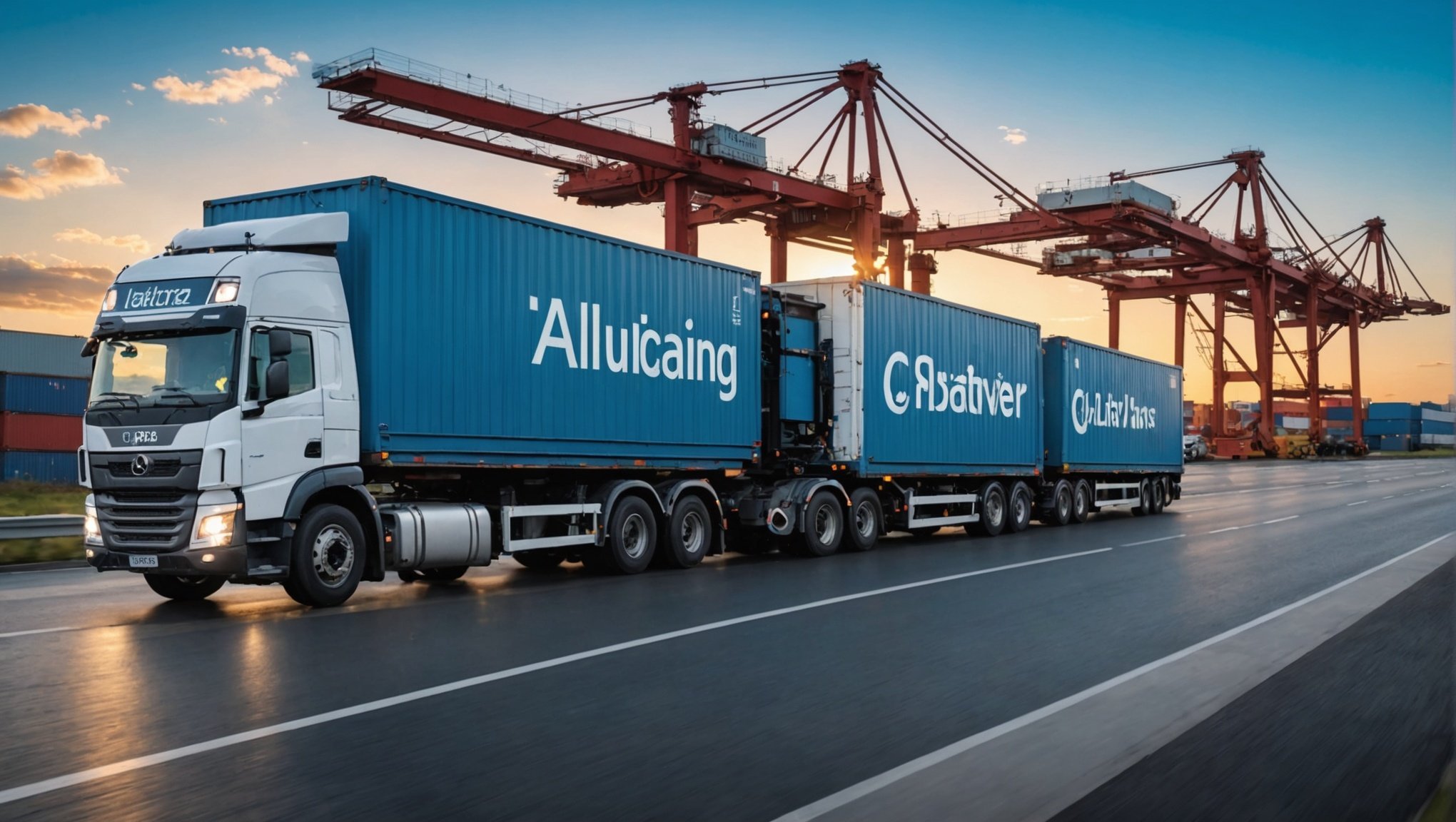Unlocking the Power of AI: Transforming Logistics and Delivery Systems for Greater Efficiency
In the fast-paced world of logistics, the integration of artificial intelligence (AI) is revolutionizing how companies manage their supply chains, optimize operations, and deliver products to customers. This article delves into the transformative impact of AI on logistics and delivery systems, highlighting key benefits, real-world examples, and practical insights for businesses looking to leverage this technology.
The Role of AI in Logistics: An Overview
AI, encompassing technologies like machine learning, natural language processing, and predictive analytics, is being increasingly adopted in the logistics industry to enhance efficiency, reduce costs, and improve customer satisfaction. Here’s how AI is making a significant difference:
Also to see : Unlocking Precision: Leveraging AI to Boost the Accuracy of Financial Trading Algorithms
Automated Order Fulfillment
Manual picking, packing, and sorting processes in warehouses can be prone to errors and delays. AI-powered robots, such as Amazon’s Sparrow and FedEx’s sorting robots, are changing this landscape. These robots can work tirelessly without breaks, handling repetitive tasks with greater accuracy and speed than human staff. For instance, Amazon’s Sparrow robot can locate, retrieve, handle, and move individual products within the warehouse, significantly improving order fulfillment times and customer satisfaction.
Real-Time Inventory Management
AI-driven systems integrated with IoT sensors and RFID tags enable real-time tracking of inventory. This data, combined with historical sales data and market trends analyzed by machine learning algorithms, allows for accurate demand forecasting. Companies like Walmart have implemented AI-powered demand forecasting to reduce excess inventory by 10-15% and improve product availability for customers.
This might interest you : Revolutionizing Language Translation: Enhancing Accuracy Through AI Innovations
Streamlined Logistics and Delivery
AI is not just confined to warehouse operations; it is also transforming the logistics and delivery processes.
Route Optimization
AI analyzes real-time traffic data, road conditions, and other factors to determine the most efficient delivery routes. This reduces travel time and fuel costs, making deliveries faster and cheaper. DHL, for example, has used route optimization algorithms to cut down delivery times and reduce fuel costs significantly.
Real-Time Shipment Tracking
AI-powered tracking systems provide real-time visibility into shipments, allowing companies to monitor their progress and anticipate potential delays. This enhances customer service by keeping customers informed about the status of their orders.
Predictive Maintenance
Predictive maintenance is another area where AI excels. By continuously analyzing data from IoT sensors and equipment, AI can detect anomalies and predict when failures could occur. This allows for proactive maintenance scheduling during non-peak hours, reducing the risk of costly equipment downtime and enhancing warehouse safety. Companies like DHL and General Electric are already implementing AI-driven predictive maintenance systems.
The Benefits of AI for Supply Chain Management
The adoption of AI in supply chain management offers numerous benefits that can significantly impact a company’s bottom line.
Efficiency and Cost Savings
Early adopters of AI-enabled supply chain management have reported a 10% reduction in logistics costs, a 20% reduction in inventory levels, and a 4% increase in revenue, according to a McKinsey report. AI helps optimize inventory to reduce waste and storage costs, predict demand fluctuations with up to 50% greater accuracy, and streamline logistics to get products to customers faster and cheaper.
Improved Customer Satisfaction
AI-driven logistics solutions enhance customer satisfaction by ensuring timely and accurate deliveries. Real-time tracking and predictive analytics help in managing customer expectations and reducing the likelihood of delays or lost shipments.
Real-World Examples of AI in Logistics
Several leading companies are already leveraging AI to transform their logistics operations.
Walmart
Walmart has implemented AI-powered demand forecasting and inventory management to streamline its massive supply chain operations. This has resulted in a reduction of excess inventory and improved product availability for customers. Walmart’s use of AI ensures that stock levels meet customer demand accurately, reducing the risk of overstocking or shortages.
DHL
DHL has integrated AI into its logistics and warehousing operations to enhance efficiency. AI-powered Locus Autonomous Mobile Robots (AMRs) help employees automate and optimize picking and order fulfillment tasks. DHL has also developed AI-powered software, OptiCarton, to determine the ideal shipment overpack, reducing outer cardboard packaging by 50% and minimizing carbon emissions.
How AI is Transforming Warehouse Operations
Warehouses are the backbone of supply chain operations, and AI is revolutionizing how they function.
Optimizing Warehouse Layout and Processes
AI can analyze data related to layout design, picking routes, and other operational processes to identify improvements. This enables companies to optimize space to store more products, reduce costs, identify the most efficient picking paths, and pinpoint bottlenecks in other processes to enhance overall warehouse efficiency.
Visual Inspection and Quality Control
AI-powered visual inspection systems ensure that products shipped are free of defects. Computer vision technologies can inspect products in real-time, reducing the need for manual inspections and improving the quality of products delivered to customers.
Practical Insights and Actionable Advice
For businesses looking to integrate AI into their logistics operations, here are some practical insights and actionable advice:
Start with Data Integration
Ensure that your systems can integrate data from various sources such as IoT sensors, RFID tags, and warehouse management systems (WMS). This integrated data will be crucial for AI algorithms to analyze and provide valuable insights.
Invest in Predictive Analytics
Predictive analytics can help in demand forecasting, inventory management, and predictive maintenance. This proactive approach can reduce costs, improve efficiency, and enhance customer satisfaction.
Automate Repetitive Tasks
Automate tasks such as picking, packing, and sorting using AI-powered robots. This will free up your staff for more strategic tasks and improve the accuracy and speed of order fulfillment.
Table: Benefits of AI in Logistics
| Benefit | Description | Example |
|---|---|---|
| Cost Savings | Reduction in logistics costs and inventory levels | 10% reduction in logistics costs, 20% reduction in inventory levels |
| Improved Efficiency | Streamlined logistics and delivery processes | DHL’s route optimization reducing delivery times and fuel costs |
| Enhanced Customer Satisfaction | Timely and accurate deliveries | Walmart’s AI-powered demand forecasting improving product availability |
| Predictive Maintenance | Proactive maintenance scheduling to reduce equipment downtime | DHL and General Electric implementing AI-driven predictive maintenance |
| Inventory Optimization | Accurate demand forecasting and real-time inventory tracking | Walmart reducing excess inventory by 10-15% |
| Route Optimization | Determining the most efficient delivery routes | DHL cutting down delivery times and reducing fuel costs |
| Real-Time Tracking | Monitoring shipments in real-time | AI-powered tracking systems enhancing customer service |
Detailed List: Key AI Technologies in Logistics
- Machine Learning (ML): Analyzes historical data and market trends to forecast inventory needs and optimize logistics operations.
- Natural Language Processing (NLP): Enhances communication between systems and humans, facilitating smoother logistics operations.
- Predictive Analytics: Predicts potential supply chain disruptions and equipment failures, enabling proactive measures.
- Computer Vision (CV): Inspects products in real-time to ensure quality and detect defects.
- Internet of Things (IoT): Provides real-time data from sensors and RFID tags to optimize inventory management and warehouse operations.
- Generative AI: Develops new product designs, optimizes supply chain networks, and enhances supplier selection based on learned patterns.
Quotes from Industry Leaders
- “AI can help you optimize your inventory to reduce waste and storage costs, predict demand fluctuations with up to 50% greater accuracy, and streamline your logistics to get products to your customers faster and cheaper.” – CloudSeed.Studio
- “By continuously analyzing data from IoT sensors and equipment, AI can detect anomalies and predict when failures could occur, allowing for proactive maintenance scheduling during non-peak hours.” – Fishbowl Inventory
- “DHL has revolutionized its warehouse and distribution operations by deploying AI-powered Locus Autonomous Mobile Robots (AMRs) that help employees automate and optimize picking and order fulfillment tasks.” – EffectiveSoft
The integration of AI in logistics and delivery systems is a game-changer for businesses aiming to enhance efficiency, reduce costs, and improve customer satisfaction. From automated order fulfillment and real-time inventory management to predictive maintenance and route optimization, AI is transforming every aspect of the logistics industry. By embracing AI technologies, companies can stay competitive, meet the growing demands of modern supply chains, and unlock new levels of efficiency and innovation.
As we move forward in this era of technological advancement, it is clear that AI will continue to play a pivotal role in shaping the future of logistics. Whether you are a small business or a global enterprise, the time to leverage the power of AI is now.












